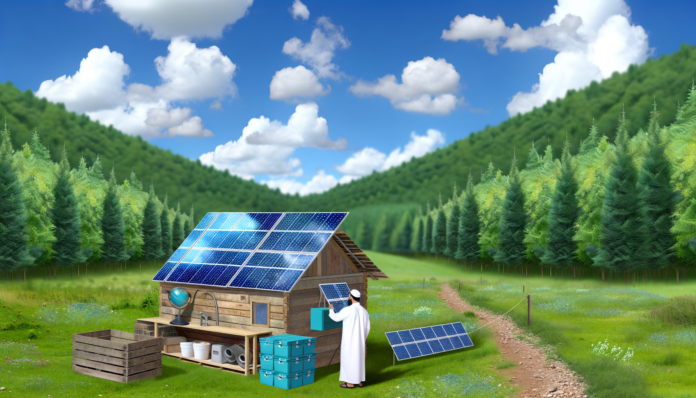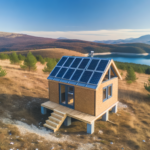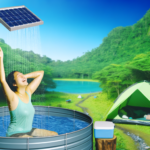Introduction to Off-Grid Solar Power
Why Choose Off-Grid Solar?
Choosing off-grid solar power is a significant decision that offers a range of benefits and opportunities for independence. One of the primary reasons people opt for off-grid solar is the desire for energy independence. By generating your own electricity, you are no longer reliant on the grid, which can be particularly advantageous in remote areas where grid access is limited or non-existent. Additionally, off-grid solar systems provide a reliable power source during natural disasters or grid failures, ensuring that you have electricity when you need it most.
Benefits of Off-Grid Solar Systems
Off-grid solar systems come with numerous benefits that make them an attractive option for many. Here are some key advantages:
- Energy Independence: As mentioned, off-grid systems allow you to generate your own electricity, freeing you from reliance on utility companies.
- Environmental Impact: Solar power is a clean, renewable energy source that reduces your carbon footprint and helps combat climate change.
- Cost Savings: While the initial investment can be high, off-grid solar systems can save you money in the long run by eliminating monthly electricity bills.
- Scalability: Off-grid systems can be scaled to meet your energy needs, whether you’re powering a small cabin or a large home.
- Resilience: Off-grid systems provide a reliable power source during emergencies, ensuring you have electricity even when the grid is down.
Understanding the Basics of Solar Power
To fully appreciate the benefits of off-grid solar power, it’s essential to understand the basics of how solar power works. Solar power systems convert sunlight into electricity using solar panels. Here’s a brief overview of the key components and how they work together:
- Solar Panels: These are the primary components that capture sunlight and convert it into direct current (DC) electricity. There are three main types of solar panels: monocrystalline, polycrystalline, and thin-film. Monocrystalline panels are the most efficient but also the most expensive, while polycrystalline panels offer a balance between cost and efficiency. Thin-film panels are less efficient but can be useful in specific applications.
- Charge Controllers: These devices regulate the voltage and current coming from the solar panels to the batteries, preventing overcharging and ensuring efficient energy storage.
- Batteries: Batteries store the electricity generated by the solar panels for use when the sun isn’t shining. The type and capacity of batteries you choose will depend on your energy needs and budget.
- Inverters: Inverters convert the DC electricity stored in the batteries into alternating current (AC) electricity, which is what most household appliances use.
- Mounting Systems: These are used to securely attach the solar panels to your roof or another structure, ensuring they are positioned to capture the maximum amount of sunlight.
Understanding these components and how they work together is crucial for planning and maintaining an efficient off-grid solar system. By choosing the right components and properly installing and maintaining your system, you can enjoy the many benefits of off-grid solar power for years to come.
Planning Your Off-Grid Solar Setup
Assessing Your Energy Needs
Before diving into the world of off-grid solar power, it’s crucial to understand your energy requirements. Conducting a thorough power audit is the first step. This involves listing all the electrical devices you plan to use, their wattage, and the estimated hours of usage per day.
For instance, a family of four might use:
- Refrigerator: 150 watts, 24 hours/day
- LED Lighting: 10 watts each, 5 hours/day
- Television: 100 watts, 4 hours/day
- Computers: 200 watts, 6 hours/day
- Washing Machine: 500 watts, 1 hour/day
Summing up these values will give you a rough estimate of your daily energy consumption in watt-hours (Wh). This figure is essential for determining the size of your solar panels, battery storage, and other system components. Remember, energy needs can vary significantly based on lifestyle, location, and the efficiency of your appliances.
Site Evaluation and Solar Potential
The next step is to evaluate your site for its solar potential. This involves assessing factors such as:
- Sunlight Exposure: Measure the amount of sunlight your location receives throughout the year. Tools like solar pathfinders or online resources like PVWatts can help you estimate solar irradiance.
- Shading: Identify any potential obstructions like trees, buildings, or mountains that could cast shadows on your solar panels. Even partial shading can significantly reduce the efficiency of your system.
- Orientation and Tilt: The angle and direction of your solar panels affect their efficiency. In the Northern Hemisphere, panels should generally face south and be tilted at an angle equal to your latitude for optimal performance.
Conducting a thorough site evaluation ensures that you maximize the efficiency and output of your solar system.
Budgeting for Your Solar Setup
Budgeting is a critical aspect of planning your off-grid solar setup. The cost of an off-grid solar system can vary widely based on the size and quality of the components you choose. Here are some key expenses to consider:
- Solar Panels: The cost of solar panels can range from $0.50 to $1.00 per watt. Monocrystalline panels are more efficient but also more expensive than polycrystalline panels.
- Batteries: Battery storage is one of the most significant expenses. Lithium-ion batteries are more efficient and have a longer lifespan than lead-acid batteries but come at a higher cost.
- Charge Controllers and Inverters: These components are essential for managing the flow of electricity. MPPT charge controllers and pure sine wave inverters are recommended for their efficiency and reliability.
- Mounting Systems: The cost of mounting systems can vary based on whether you choose ground mounts, roof mounts, or tracking systems.
- Installation: If you opt for professional installation, labor costs can add significantly to your budget. DIY installation can save money but requires a good understanding of electrical systems and safety protocols.
It’s also wise to allocate a portion of your budget for maintenance and potential upgrades. By carefully planning and budgeting, you can ensure that your off-grid solar setup is both efficient and cost-effective.
Essential Components of an Off-Grid Solar System
Solar Panels
Solar panels are the heart of any off-grid solar system, converting sunlight into electricity. There are three main types of solar panels: **Monocrystalline**, **Polycrystalline**, and **Thin Film**.
- Monocrystalline: These panels are made from a single crystal of silicon, making them the most efficient type, with efficiency rates ranging from 17% to 22%. They are also the most expensive but offer the best performance and a sleek aesthetic.
- Polycrystalline: Made from multiple silicon crystals, these panels are slightly less efficient, with rates between 15% and 17%. They are more affordable and commonly used in residential installations.
- Thin Film: These panels are created by depositing a thin layer of photovoltaic material onto a surface like glass. They are less efficient (10-13%) but can generate electricity in low-light conditions, making them suitable for large-scale industrial applications.
For most residential setups, **monocrystalline panels** are recommended for their higher efficiency and better performance, despite the higher cost.
Charge Controllers
Charge controllers regulate the voltage and current coming from the solar panels to the batteries. There are two main types: **PWM (Pulse Width Modulation)** and **MPPT (Maximum Power Point Tracking)**.
- PWM Controllers: These are simpler and less expensive but less efficient. They work best with solar panels that have a voltage close to that of the battery bank.
- MPPT Controllers: These are more advanced and efficient, capable of converting excess voltage into additional current. They are more expensive but offer better performance, especially in varying weather conditions.
For optimal performance, an **MPPT charge controller** is highly recommended.
Batteries
Batteries store the electricity generated by the solar panels for use when the sun isn’t shining. The main types of batteries used in off-grid systems are **Lead Acid**, **AGM (Absorbent Glass Mat)**, and **Lithium**.
- Lead Acid: These are the most affordable but require regular maintenance and have a shorter lifespan.
- AGM: These are a type of lead-acid battery that is maintenance-free and has a longer lifespan but is more expensive.
- Lithium: These are the most expensive but offer the best performance, longest lifespan, and are maintenance-free. They are also lighter and more efficient.
**Lithium batteries** are generally the best choice for off-grid systems due to their efficiency and longevity, despite the higher initial cost.
Inverters
Inverters convert the DC (direct current) electricity stored in the batteries into AC (alternating current) electricity, which is used by most household appliances. There are three main types of inverters: **Square Wave**, **Modified Sine Wave**, and **Pure Sine Wave**.
- Square Wave: These are the least expensive but can damage sensitive electronics.
- Modified Sine Wave: These are more efficient than square wave inverters but still not ideal for sensitive electronics.
- Pure Sine Wave: These provide the cleanest power, similar to that from the grid, and are suitable for all types of electronics.
A **Pure Sine Wave inverter** is recommended for its compatibility with all household appliances and electronics.
Mounting Systems
Mounting systems are used to secure the solar panels to your roof or another structure. The main types are **fixed mounts**, **adjustable mounts**, and **tracking mounts**.
- Fixed Mounts: These are the simplest and least expensive but do not allow for adjustment to optimize the angle of the panels.
- Adjustable Mounts: These allow you to change the angle of the panels to maximize solar exposure throughout the year.
- Tracking Mounts: These are the most expensive and complex but offer the highest efficiency by automatically adjusting the panels to follow the sun’s path.
For most residential setups, **adjustable mounts** offer a good balance between cost and efficiency.
By carefully selecting and integrating these essential components, you can create an efficient and reliable off-grid solar system tailored to your specific needs.
Installation Process
DIY vs. Professional Installation
When it comes to installing an off-grid solar system, one of the first decisions you’ll need to make is whether to go the DIY route or hire a professional. Each option has its own set of advantages and disadvantages.
DIY Installation:
- Cost Savings: One of the most significant benefits of DIY installation is the potential for cost savings. By doing the work yourself, you can save on labor costs, which can be substantial.
- Learning Experience: Installing your own system can be a valuable learning experience, giving you a deeper understanding of how your system works and how to maintain it.
- Flexibility: You have complete control over the installation process, allowing you to work at your own pace and make adjustments as needed.
Professional Installation:
- Expertise: Professionals bring a wealth of experience and knowledge, ensuring that your system is installed correctly and efficiently.
- Time-Saving: Hiring a professional can save you a significant amount of time, as they can complete the installation much faster than a DIY approach.
- Warranty and Support: Many professional installers offer warranties and ongoing support, providing peace of mind and assistance if any issues arise.
Step-by-Step Installation Guide
Whether you choose to go DIY or hire a professional, understanding the basic steps involved in installing an off-grid solar system is crucial.
- Site Assessment: Evaluate your site to determine the best location for your solar panels. Consider factors such as sunlight exposure, shading, and roof orientation.
- System Design: Design your system based on your energy needs and site assessment. This includes selecting the appropriate number and type of solar panels, batteries, charge controllers, and inverters.
- Mounting the Panels: Install the mounting system on your roof or ground. Ensure that the mounts are securely fastened and properly aligned to maximize sunlight exposure.
- Installing the Panels: Attach the solar panels to the mounting system. Connect the panels in series or parallel, depending on your system design.
- Wiring: Run the wiring from the solar panels to the charge controller, batteries, and inverter. Use appropriate gauge wires and ensure all connections are secure and weatherproof.
- Connecting the Components: Connect the charge controller to the batteries and the inverter. Follow the manufacturer’s instructions for proper wiring and configuration.
- Testing the System: Once everything is connected, test the system to ensure it is functioning correctly. Check for proper voltage and current levels, and verify that the system is charging the batteries and providing power to your appliances.
Safety Considerations
Safety should be a top priority during the installation process. Here are some key safety considerations to keep in mind:
- Electrical Safety: Solar installations involve working with electricity, which can be dangerous if not handled properly. Always turn off the power before working on any electrical components, and use insulated tools and protective gear.
- Structural Safety: Ensure that your roof or mounting structure can support the weight of the solar panels and mounting system. If in doubt, consult a structural engineer.
- Weather Considerations: Avoid installing your system during adverse weather conditions, such as high winds or rain, which can increase the risk of accidents.
- Proper Grounding: Properly ground your system to protect against electrical surges and lightning strikes. Follow local codes and regulations for grounding requirements.
- Fire Safety: Use fire-resistant materials and follow best practices for electrical wiring to minimize the risk of fire. Regularly inspect your system for any signs of wear or damage.
By carefully considering whether to DIY or hire a professional, following a step-by-step installation guide, and prioritizing safety, you can ensure a successful and efficient off-grid solar system installation.
Maintenance and Troubleshooting
Regular Maintenance Tasks
Maintaining your off-grid solar system is crucial to ensure its longevity and efficiency. Here are some regular maintenance tasks you should perform:
- Cleaning Solar Panels: Dust, dirt, and debris can accumulate on your solar panels, reducing their efficiency. Clean them with water and a soft brush or cloth every few months, or more frequently if you live in a dusty area.
- Inspecting Connections: Regularly check all electrical connections for signs of corrosion or wear. Tighten any loose connections to prevent energy loss and potential hazards.
- Battery Maintenance: For lead-acid batteries, check the electrolyte levels and top up with distilled water if necessary. Ensure that battery terminals are clean and free from corrosion.
- Monitoring System Performance: Use your system’s monitoring tools to track performance metrics. Look for any significant drops in energy production, which could indicate a problem.
- Checking Inverters and Charge Controllers: Ensure that inverters and charge controllers are functioning correctly. Look for any error messages or warning lights and address them promptly.
Common Issues and Solutions
Even with regular maintenance, issues can arise. Here are some common problems and their solutions:
- Reduced Power Output: If your system is producing less power than expected, check for shading on the panels, dirty panels, or faulty connections. Clean the panels and inspect the wiring.
- Battery Issues: If your batteries are not holding a charge, they may be old or damaged. Test the batteries with a multimeter and replace any that are underperforming.
- Inverter Problems: If the inverter is not working, check for tripped breakers or blown fuses. Ensure that the inverter is properly ventilated to prevent overheating.
- Charge Controller Errors: If the charge controller shows an error, refer to the manual for troubleshooting steps. Common issues include incorrect settings or wiring problems.
- System Overheating: Ensure that all components, especially inverters and batteries, are in well-ventilated areas. Overheating can lead to reduced efficiency and damage.
When to Call a Professional
While many maintenance tasks and minor issues can be handled by the system owner, there are times when professional help is necessary:
- Complex Electrical Issues: If you encounter complex electrical problems that you are not comfortable handling, it’s best to call a licensed electrician.
- Major Component Failures: If a major component like the inverter or charge controller fails, a professional can diagnose and replace the part safely and efficiently.
- System Upgrades: When upgrading your system, such as adding more panels or batteries, a professional can ensure that the new components are integrated correctly.
- Warranty Repairs: If your system components are still under warranty, it’s advisable to have a professional handle any repairs to avoid voiding the warranty.
- Safety Concerns: If you notice any signs of overheating, burning smells, or other safety hazards, turn off the system and call a professional immediately.
Regular maintenance and prompt troubleshooting are key to keeping your off-grid solar system running smoothly. By staying proactive, you can ensure that your system remains efficient and reliable for years to come.
Maximizing Efficiency and Performance
Energy Conservation Tips
Maximizing the efficiency of your off-grid solar system starts with energy conservation. Here are some practical tips to help you reduce energy consumption:
- Use Energy-Efficient Appliances: Opt for appliances with high energy efficiency ratings. Look for Energy Star-rated products, which consume less power and are designed to be more efficient.
- LED Lighting: Replace incandescent bulbs with LED lights. LEDs use significantly less energy and have a longer lifespan.
- Unplug Unused Devices: Many devices consume power even when turned off. Unplug chargers, electronics, and appliances when not in use to avoid phantom loads.
- Optimize Heating and Cooling: Use programmable thermostats to regulate heating and cooling. Insulate your home properly to maintain temperature and reduce the load on your HVAC system.
- Water Heating: Consider solar water heaters or on-demand water heaters, which are more efficient than traditional tank heaters.
Upgrading Your System
As technology advances, upgrading your off-grid solar system can significantly enhance its performance and efficiency. Here are some key upgrades to consider:
- High-Efficiency Solar Panels: Newer solar panels offer higher efficiency rates, meaning they can convert more sunlight into electricity. Upgrading to high-efficiency panels can increase your energy production without needing additional space.
- Advanced Inverters: Modern inverters come with better efficiency and additional features like remote monitoring and smart grid capabilities. Upgrading your inverter can improve the overall performance of your system.
- Battery Storage: Upgrading to lithium-ion batteries, such as LiFePO4, can provide better energy storage, longer lifespan, and higher efficiency compared to traditional lead-acid batteries.
- Smart Controllers: Implementing smart charge controllers can optimize the charging process, protect your batteries, and provide real-time data on your system’s performance.
Seasonal Adjustments
Seasonal changes can impact the performance of your off-grid solar system. Here are some adjustments to consider for maximizing efficiency throughout the year:
- Panel Angle Adjustment: Adjust the tilt angle of your solar panels to match the seasonal sun path. In winter, a steeper angle can capture more sunlight, while a flatter angle is better for summer months.
- Regular Cleaning: Dust, snow, and debris can reduce the efficiency of your solar panels. Regularly clean your panels to ensure they receive maximum sunlight.
- Energy Usage Patterns: Adjust your energy usage based on seasonal availability. For example, plan high-energy activities during sunny days and reduce usage during cloudy or short winter days.
- Backup Power: Ensure you have a reliable backup power source, such as a generator, for periods of low sunlight. This can help maintain power supply during extended cloudy or winter periods.
By implementing these energy conservation tips, upgrading your system, and making seasonal adjustments, you can significantly enhance the efficiency and performance of your off-grid solar setup. This not only ensures a reliable power supply but also extends the lifespan of your system components, providing long-term benefits.
Future Trends in Off-Grid Solar Technology
Emerging Technologies
The landscape of off-grid solar technology is rapidly evolving, driven by continuous advancements in various fields. One of the most promising emerging technologies is **perovskite solar cells**. These cells offer higher efficiency rates and lower production costs compared to traditional silicon-based solar panels. Additionally, **bifacial solar panels** are gaining traction. These panels can capture sunlight from both sides, significantly increasing energy output, especially in snowy or reflective environments.
Another exciting development is the integration of **solar energy with blockchain technology**. Blockchain can facilitate peer-to-peer energy trading, allowing off-grid communities to trade excess energy seamlessly. This decentralized approach not only enhances energy security but also promotes community resilience.
Sustainable Innovations
Sustainability is at the core of off-grid living, and innovations in this area are making off-grid solar systems more eco-friendly and efficient. **Recyclable solar panels** are becoming more prevalent, addressing the issue of electronic waste. Companies are developing panels that can be easily disassembled and recycled, reducing the environmental impact.
**Energy storage solutions** are also seeing sustainable innovations. **Solid-state batteries** are emerging as a safer and more efficient alternative to traditional lithium-ion batteries. These batteries offer higher energy densities and longer lifespans, making them ideal for off-grid applications. Additionally, **second-life batteries**, repurposed from electric vehicles, are being used for solar energy storage, providing a cost-effective and sustainable solution.
The Future of Off-Grid Living
The future of off-grid living is set to be more integrated and autonomous, thanks to advancements in smart technology. **Smart home systems** that can optimize energy usage based on real-time data are becoming more accessible. These systems can manage energy consumption, storage, and generation, ensuring maximum efficiency and minimal waste.
**Microgrids** are another significant trend. These localized grids can operate independently or in conjunction with the main grid, providing reliable power to off-grid communities. Microgrids enhance energy security and can be tailored to specific community needs, incorporating various renewable energy sources like wind and solar.
Lastly, the concept of **self-sustaining homes** is gaining momentum. These homes are designed to be entirely self-sufficient, incorporating not just solar power but also water recycling systems, organic waste management, and sustainable building materials. The goal is to create homes that have minimal environmental impact while providing all the comforts of modern living.
In conclusion, the future of off-grid solar technology is bright, with numerous emerging technologies and sustainable innovations on the horizon. These advancements promise to make off-grid living more efficient, sustainable, and accessible, paving the way for a greener and more self-reliant future.






